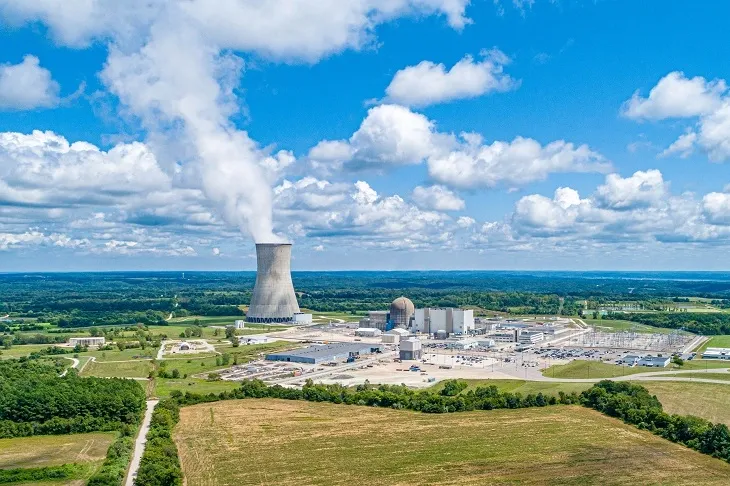Duggan Flanakin
Duggan Flanakin is a Senior Policy Analyst with the Committee For A Constructive Tomorrow. A former Senior Fellow with the Texas Public Policy Foundation, Mr. Flanakin authored definitive works on the creation of the Texas Commission on Environmental Quality and on environmental education in Texas.
Despite its commitment to “no more gas, oil, or coal,” Friends of the Earth has launched a campaign against one of the nation’s “greenest” governors, California’s Gavin Newsom. Their goal? To stop the U.S. Department of Energy from doling out $1 billion to keep the Diablo Canyon nuclear power plant (no gas, oil, or coal there) open past its planned 2025 closure date.
Newsom, whose policies are among the world’s most aggressive against gasoline- and diesel-powered vehicles and tools, last year stated that “the Diablo Canyon power plant is important to support energy reliability as we accelerate progress towards achieving our clean energy and climate goals.” Diablo Canyon today supplies nearly a tenth of California’s electricity.
The aptly named FOE claims that “the environmental impacts from extending the lifespan of this aging power plant at this point in time have not been adequately addressed or disclosed to the public.” Other groups, too, spread fear about nuclear energy. But by far the most powerful obstacle for nuclear energy enthusiasts to overcome lies within the federal government.
While nuclear energy has accounted for about 20% of the electricity generated in the U.S. and 2023, supplied nearly half the nation’s carbon-free electricity, a new report from the Government Accountability Office says the Nuclear Regulatory Commission must more fully consider possible impacts of climate change on the nation’s mostly aging nuclear power plants.
The message? The GAO report says that climate-related threats to nuclear power plants range from worsened droughts that dry up water supplies needed for cooling reactors to sea level rise and storm surge flooding. Despite its regulatory obtuseness, the report said the NRC should include “data” from future climate projections [scary scenarios?] in safety risk assessments along with the historical data the NRC relies upon. All this adds costs.
Douglas McIntyre, the former editor-in-chief of 24/Wall St., last month said that, despite the obvious need for nuclear power, “many Americans, perhaps remembering Three Mile Island, do not want nuclear energy to be part of the solution.” And a recent Pew Research poll found that “Critics highlight the high cost of nuclear power plant projects and the complexities of handling radioactive waste.”
By contrast, the U.S. Department of Energy has argued that the U.S. will need an additional 550 to 770 gigawatts of clean, firm capacity to reach net-zero carbon dioxide emissions and that nuclear power is one of the few proven options that can fill this need. Moreover, nuclear power plants create high-paying jobs with concentrated economic benefits for the communities most impacted by the energy transition.
These dichotomous messages from the DOE and NRC are highlighted in a recent article by ThorCon International co-founder Robert Hargraves, who bluntly stated that the U.S. is not building commercial nuclear power plants – while 16 other nations are – “because NRC and EPA regulators are so misinformed about radiation.”
Regulatory overkill is a likely culprit in the failed six-reactor, 462-megawatt project NuScale had planned in cooperation with Utah Associated Municipal Power Systems, part of the DOE’s Carbon Free Power initiative for small modular reactors. Several towns pulled out and sank the project as the estimated price for power rose from $58 per megawatt-hour (MWh) to $89/MWh.
Misguided safety assumptions created a regulatory jungle so complex that startup Atomic Canyon is offering AI to help applicants navigate the NRC’s database of 52 million documents. U.S. nuclear energy regulators, Hargraves charged, do not analyze data about human health effects of radiation from nuclear power; instead, they rely on groupthink consensus evolved in NGOs originally misled in the 1950s by grant-seeking geneticists.
For decades these geneticists claimed radiation damage to chromosomes was increasing. But when children of the survivors of the Nagasaki and Hiroshima atomic bomb attacks exhibited no such effects, the anti-nuclear scientists switched to alleged cancer impacts. And a major flaw in their analysis is what caused the cost of nuclear energy to skyrocket.
While studies of those survivors found no excess cancers in people receiving less than 0.1 Gray (joules of energy absorbed by kilogram of tissue), regulators set public radiation limits 100 times lower, mistakenly limiting accumulated dose rather than dose rate. In the real world, setting a maximum daily dose of 0.02 Gray (rather than the current maximum cumulative annual dose of 0.001 Gray) would provide a large safety margin.
Salisbury University Professor of Finance Danny Ervin pooh-poohs the fears of nuclear foes, saying, “The next wave of nuclear can’t come soon enough.” That “next wave” includes scalable nuclear reactors, notably the TerraPower initiative sparked by Bill Gates. This advanced facility, coupled with a molten salt energy storage system, will be capable of increasing output for nearly six hours during peak demand periods at a projected cost of about $4 billion.
The plant will be powered by an advanced Natrium reactor cooled with liquid sodium instead of water [eliminating one concern of skeptics]. With a capacity to generate up to 500 megawatts, it will provide ample energy to power approximately 400,000 homes.
Of equal importance is that its location at a former coal-fired power plant in Wyoming enables easy integration into the existing electric grid while stimulating the local economy. This contrasts with wind turbines and solar arrays, which often are located far from existing transmission lines, require massive footprints, and operate intermittently, thus requiring backup power generation.
Over in England, X-Energy, in partnership with Babcock International subsidiary Cavendish, has proposed to develop a 12-reactor plant using the company’s Xe-100 high-temperature gas-cooled reactor design. The Teesside array, which should be operational by the early 2030s, is the first of what the companies hope will be a fleet of up to 40 of the 80 MWe power plants in locations across the United Kingdom.
Cavendish Nuclear managing director Mick Gornall boasts that “a fleet of Xe-100s can complement renewables by providing constant or flexible power, producing steam to decarbonize industry, and manufacturing hydrogen and synthetic transport fuels. Deployment will also, he said, create thousands of high-quality, long-term jobs nationwide.
Uranium-rich Nigeria thinks it has a solution to the radioactive waste management issue that has been a big bugaboo for the nuclear energy industry worldwide. The solution relies on the NST SuperLAT, which NuclearSAFE Technology co-founder Dr. Jimmy Etti-Williams calls “a breakthrough in nuclear waste management”.
SuperLAT will, says Etti-Williams, process, package, load, store, and transport nuclear waste in casket containers to several thousand feet underground, yet able to be retrieved as needed for fuel in reactors to generate low-carbon-footprint energy. This geological nuclear waste disposal technology is designed to isolate and dilute nuclear waste in line with universal regulations.
The SuperLAT technology should, says Etti-Williams, satisfy the International Atomic Energy Agency and other stakeholder concerns about nuclear waste storage accidents, leakages, or terror risks. He boasts that Nigeria can have its own uranium plants to boost its own and pan-African development efforts.
There’s an old saying, which first appeared in 1902 in Puck’s Magazine, with the message, “People who say it cannot be done should not interrupt those who are doing it.” It is high time, many now believe, for the nay-saying over-regulators to stop interrupting nuclear progress.
And on that front, too, there is good news. Nuclear Matters has announced an online gathering entitled “The Path to Progress: Modernizing the NRC,” scheduled for May 2.
At the event, a four-person panel moderated by the Nuclear Energy Institute’s John Kotek will discuss the urgency of NRC modernization in order to unlock the benefits of nuclear technology innovation to revitalize the U.S. nuclear energy industry.
The anti-nuke FOEs (sic) will have little left to argue once these and other innovative nuclear projects prove successful and safe when brought to the fore in other nations – places like England and Nigeria. But those who seek reliable, safe, and clean technologies to generate the electricity in quantities needed tomorrow will only be satisfied if the archaic rules can be recrafted to accommodate them.
This article originally appeared at Real Clear Energy









